Software designed exclusively for the US Powerball lottery
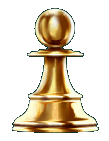


© Copyright Randomware LLC
~ Powerball Numbers Analysis ~
How many times have you gone through your "Quick Picks" after a Powerball lottery drawing only to find
that out of 5 pick sequences, not a single ball number matched any of the winners. More often
than not, you've said to yourself, "This is a complete waste of time & money!" Playing "Quick
Picks" very nearly is a waste of both. We all agree that there's absolutely no
chance of winning if you don't play, but with the odds you're facing, not playing might
be a more financially enlightened alternative.
Perhaps you've acknowledged that it would be wise to quit tossing your money at such ridiculous odds, but the allure
of coming into a hundred million dollars or more makes it difficult to disregard the lotteries entirely. The changes
one big win would make in our lives are just too exotic to comprehend. For some it would mean the otherwise impossible
opportunity to spend their productive hours doing the sort of activities that they enjoy, or maybe providing some support for
family, friends, or others that need a helping hand. Perhaps your concerns are geared toward the animal kingdom. Many
would love to tell that self-important CEO, district manager or local supervisor at work where to put it. Being
independently wealthy would relieve our dependence on people that we don't like, or don't trust. This is not to say that
money solves all problems, as it can create many of it's own, but it sure would be nice to try it on for size. After all,
you can always get rid of the money if you decide that you don't enjoy being independently wealthy after all.
So let's do things a little more intelligently from now on and give up this "blind faith" thing
that we've been hanging on to for so long. If you need to dig a hole to plant a tree, what's one
of the first things that you do? Of course, "Get a shovel". Using the right tool not only
makes most jobs more efficient and enjoyable, many times, the right tool makes it possible. You
could use a spoon to dig the hole, if you had days rather than minutes to get the job done. Perhaps
even a screw driver might work. The gist here is that shovels aren't all that expensive when you
consider how they enable the user to efficiently dig a hole. Nevertheless, just because a shovel
turns out to be a great tool for digging a hole, you might not want to use it to
wash your car. It's all about using the RIGHT tool for the job.
Following are some common sense tips as well as some of the benefits of using the PawnPower Numbers
Assistant, one of the easiest to use and most comprehensive tools for analyzing the Powerball lottery.
• Due Numbers
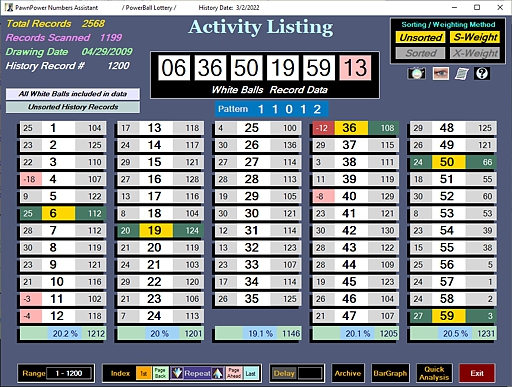
When trying to predict the next winning lottery numbers, a common strategy is to pick numbers that have not been drawn as frequently as other numbers. The logic is that these numbers are DUE and is based on the fact that the distribution of winning numbers tends to even out (more or less) over time, just as many random or chaotic processes tend to dissipate order. The problem is knowing WHEN these so called DUE numbers will actually be drawn. Conversely, a potential number is often disqualified if it has been a recent winner even though this gives no consideration to the ball number's LONG TERM activity. A fair analysis should consider the ball numbers' activity in both the short term AND the long term. One tool that PawnPower offers to help determine the most likely ball numbers adds a twist to the usual "Weighted" list of ball numbers. By including an "Activity Counter" to monitor the recent activity of each ball number, you can have both long and short term data displayed together. You then have options to sort the the charts based on ball number "Weights" with the "Activity Counters" still independently monitoring each individual cell in the chart. By distilling out the ball numbers that have likely Activity Counters in both sorted and unsorted charts, we can come up with a list of numbers that truly are the "Best Picks". It's important though, not to get caught up in the temptation to include all of your Best Picks in the same pick number sequence. As you study the details of past winning numbers you'll notice that very seldom does the winning number sequence contain ALL of the Best Picks. Your best bet is to lay out your picks using the same general layout as the previous winning numbers which typically contain one or rarely two of the most likely numbers. If the only numbers to come up in a drawing were those numbers that were due, then the drawings would not be random at all.
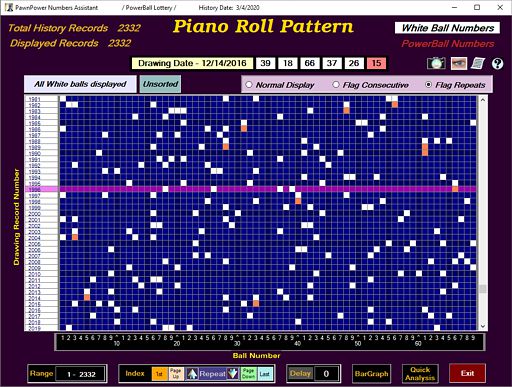
• Repeats & Consecutive Numbers
You can probably guess that choosing consecutive numbers is not a good strategy. But that doesn't apply to just two consecutive numbers. The Piano Roll Pattern module in this software package shows clearly in a simple graphical form how often numbers fall in consecutive order as well as repeats between drawings. The number of repeated and consecutive numbers will surprise you, but they generally involve only a pair of entries. It is not unusual to find two consecutive entries in a winning number, but that's pretty much the limit. That's not to say that three consecutive numbers have never popped up within the same drawing. It just happens so infrequently that it would be unwise to build your picks using such a structure. The same holds true for repeated numbers. It may not be unusual to find two consecutive winning sequences that contain a common value, but seldom do we find a series of three or more drawings in a row with a common number element. Likewise, it's not very common to find a winning number sequence with more than one repeated element. These mundane tasks are best left to an automated system and are just a few of the many functions that PawnPower's Automated Numbers Selection module handles for you behind the scenes. If you are constructing your Pick Numbers manually, then you'll need to watch these properties yourself.
• Patterns

The average individual considers Chaos Theory to be an intractable notion that is beyond
analysis. The thing about chaos is that, as we look closer, patterns begin to emerge...
"What patterns...? I can look at these numbers all day long and I don't see any patterns!"
... Well, just looking at a list of the winning ball numbers probably won't reveal any patterns to even the
most perceptive observer. Patterns that we tease from random collections such as the lottery
drawings need to be constructed from data that can be associated with the elements of the
collection. Imagine laying out all the ball numbers evenly into five columns...
Or as evenly as possible. As the winning ball numbers
fall into these columns, a pattern can be constructed using the number of hits in each column.
For example, in the Activity Listing page (above, right) the winning numbers are highlighted with
a gold background color within the 5 columns on the page. Notice that the first column has 1 winner and column 2
has 1 winner. There are no winners in column 3. Column 4 has 1 winner and column 5 has 2 winners. If
you lay out the number of winning cells in each column consecutively, we can construct a Pattern
of "1 1 0 1 2". 'Sounds a little silly, doesn't it? Yes, it does, until we scroll through the
winning numbers history and keep track of which Patterns come up most often. Some truly amazing
statistics evolve in the process.
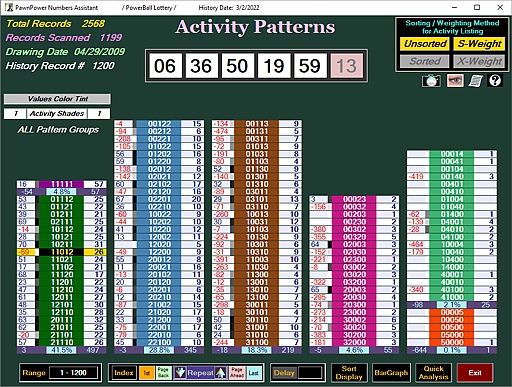 Just 17% of the possible Patterns (21 out of 126) get 40% to 50%
of the activity. This means that if you construct your Picks using these Patterns as a template,
you will have 1 chance in 21 of using a winning Pattern nearly every other drawing. The next step,
of course, is to narrow down which actual numbers to select from each column. The Patterns module
is one of several steps to rough out some guidelines for our Pick Numbers. Conversely,
knowing which Patterns come up as winners most often also tells us what Patterns NOT
to use. 60% of the possible Patterns are not good choices based on the frequency that they
appear within the winning numbers history. Of those, 60% are almost guaranteed losers. Even
if you are not critical about your Patterns selections, you can almost double you odds of
selecting a winning numbers combination just by avoiding the losing Patterns. That's an advantage
that can not be debated. Simply scanning through the numbers history reveals that these percentages
vary only by a few percent through out the entire Powerball history.
Just 17% of the possible Patterns (21 out of 126) get 40% to 50%
of the activity. This means that if you construct your Picks using these Patterns as a template,
you will have 1 chance in 21 of using a winning Pattern nearly every other drawing. The next step,
of course, is to narrow down which actual numbers to select from each column. The Patterns module
is one of several steps to rough out some guidelines for our Pick Numbers. Conversely,
knowing which Patterns come up as winners most often also tells us what Patterns NOT
to use. 60% of the possible Patterns are not good choices based on the frequency that they
appear within the winning numbers history. Of those, 60% are almost guaranteed losers. Even
if you are not critical about your Patterns selections, you can almost double you odds of
selecting a winning numbers combination just by avoiding the losing Patterns. That's an advantage
that can not be debated. Simply scanning through the numbers history reveals that these percentages
vary only by a few percent through out the entire Powerball history.
The Patterns can be tracked just as effectively as the activity of the ball numbers.
The Activity Patterns page (above, right) displays every possible Pattern grouped by type. The
Patterns have "Weights" & "Activity Counters" that are associated with each Pattern as well as
group totals & percentages just as the Activity Listing does for the ball numbers. The details of
finding the next MOST LIKELY Patterns are very similar to singling out likely ball
numbers. PawnPower's Automated selection process constructs and anaylzes these Patterns to
determine not only the best Patterns to use in general, but Patterns specifically culled as likely
to come up soon.
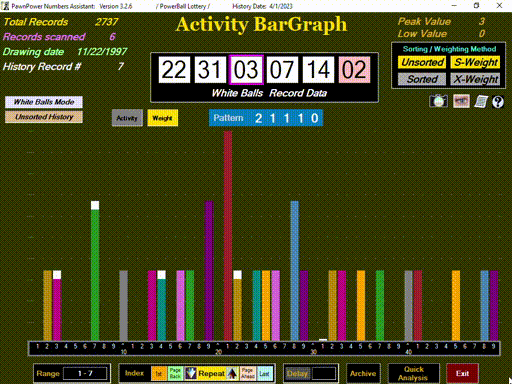
• BarGraphs
Graphs are great ! They allow a person to sit back and absorb the data in front of them without
getting caught up in the details. Bar graphs are universal favorites... Especially one that is
interactive and dynamic as opposed to a static graph of totals that just sits there. One very
useful feature of this program is the ability to set things in motion. Every chart & graph has
the option to scroll through the history in an animated sequence. The Bar Graph module literally
springs to life when this option is employed. Start at any point in the history and watch the graph
grow as the numbers history builds. Each winning number is highlighted on the graph as it progresses
displaying much more information than a simple static bar graph of totals. Here's where you can
literally see how your Pick Numbers should be laid out. Scrolling through the history of winning
numbers reveals that the ball numbers that typically come up as winners do not seem to favor those
numbers with the over all lowest activity, but the shorter bars have a way of gradually catching
up to the taller bars in the long run.
The range of drawings included in each frame of the mini-movie can be adjusted to include a fixed
number of drawings, so that the animation displays only the variability between ball numbers within
a floating, fixed length segment of the history. When set in motion, you can watch the Graph
"morph" into various configurations as the snapshot of the data moves through the history.
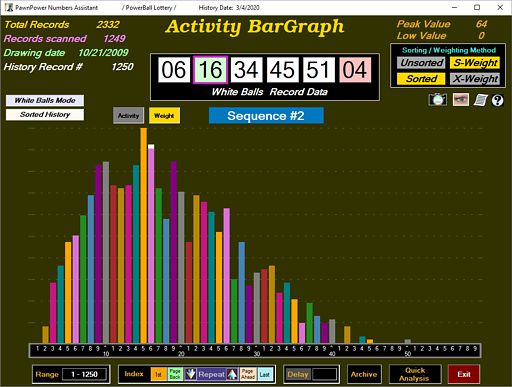
Another variation allows you to isolate a single element of the Pick Sequences and run the graph
with just one of the five drawn white ball numbers.
Compound that option with the ability to sort the History records and your graph
now displays the range of ball numbers most likely for each Pick Number element.
In the graph at the left, the 2nd element of the winning number has been singled out. The taller
the bar is in this graph, the more likely that the corresponding ball number will be drawn for
the element in the 2nd position in a sorted Pick Sequence.
Superimpose your Pick Numbers for the next drawing or from past drawings on top of these graphs to
see how your Picks measure up. Ideally you'll want to make your Picks
appear on these graphs in a similar layout as the winning numbers from the past.
The Bar Graph is unique in that it makes it easy to see how the winning numbers are
distributed between ball numbers with a variety of activity.
• Line Graphs
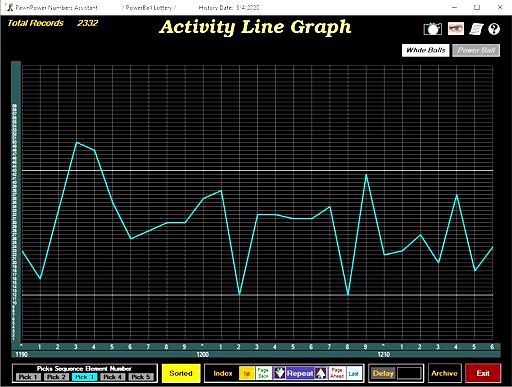

The Line Graph compliments the Bar Graph by best displaying the Activity of the ball numbers
on a very short term. Display all Pick Sequence elements together or break them up to display as
few as a single element. A great advantage stands out when you examine the details of this
graph. The lines on the graph seem to cycle up and down on a reasonably regular interval. Running
an analysis of this over various spans of the history confirms that the lines will change
direction within two drawings 88% of the time and within a single drawing 62% of the time.
To state the obvious, if you see a line on the graph that has been on the rise for two
consecutive drawings or more, your best bet is to select a ball number that would create a falling
line on the graph for the next drawing. You would have an 88% chance of being right. Choosing
exactly which number that would be however is best left to the Activity Listing module or perhaps
even a randomly generated value. This
module is used as one of several potential starting points to rough out some guide lines for
your Pick Numbers. Several Charts and Graphs in this application include the functionality
for creating a new set of Pick Numbers as well as the ability to load existing Picks from
previous drawings. Being able to select your Picks within a graphical environment really eases
the task and sets the stage for a little intuition. Don't under estimate the power of your
instinct.
• Pseudo History Files
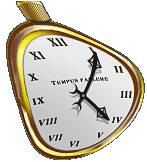
Wouldn't it be nice to see what the lottery's winning numbers look like a few weeks or months from now? You'd know ahead of time where the numbers were headed. The ability to see into the future would be a phenomenal advantage to anyone, and how they chose to benefit by it would only be limited by their own restraint. Thank goodness that it is not possible to see future events... yet! As far as seeing how the numbers history should look in the future, that is something that we CAN do now. This program includes a process to create "PSEUDO" history files. This is a set of randomly generated numbers that basically acts as a stand in for your actual drawings data. These files contain drawing dates and randomly selected numbers that for all practical purposes could be the actual drawings data. The actual drawings data is, after all, really nothing more than a collection of random numbers itself. All of the modules that are normally employed to analyze the actual winning numbers from the past can be run using these Pseudo files as a proxy. As far as the Charts, Graphs and other analytical tools are concerned, these files are indistinguishable from the real thing. There is however one big difference. These files can be constructed to run far into the future and can be any length up to 5000 drawings which, for the Powerball lottery, would represent drawings data well beyond the year 2037.
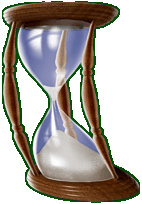
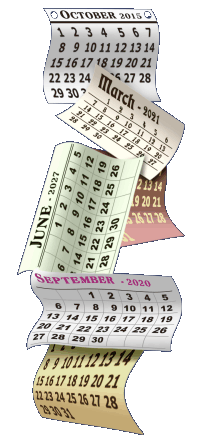
What does the Bar Graph look like 5 or 10 years from now? Are the bars all very close to the same height? How do the Patterns ultimately play out? Do the Patterns that appear to show the greatest amount of activity now also do so years from now? That really would be the ultimate long term test. Do you think the analysis that you're looking at for the actual drawings history might be an anomaly? Substitute a Pseudo file for the real numbers history and put it to the test. This is as close as you can get to looking into the future without having to recruit one of Albert Einstein's theories. This tool enables you to verify questionable results and get a feel for where the numbers are ultimately headed.
• Random Picks
If you want to add a little whimsy to your Picks, the RANDOM NUMBERS SELECTION module offers a
variation of the "Quick Picks" style of numbers selection in a format that resembles a casino
favorite, the slot machine. There have been many jackpot winners
that have won through the use of random Picks. These folks beat all odds to wind up with a
winning sequence of numbers. Their "Dumb Luck" approach appears to have worked only because there
are so many millions of people buying Quick Picks. If the odds are 300 million to 1, and 300
million Quick Picks are sold, then it's not surprising that one of those 300 million tickets
just happened to have the winning combination.
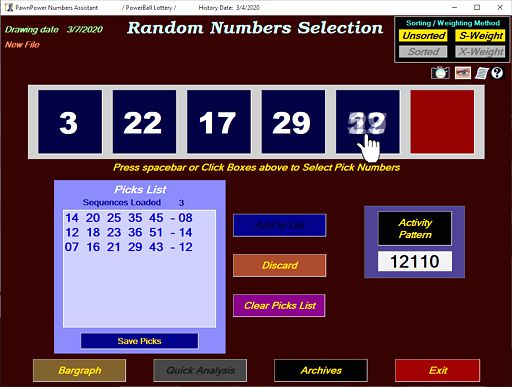 Let's not dismiss a random approach entirely
though, after all, the actual process of drawing the ball numbers is itself a random process.
So, if you really want totally randomized Picks, this module will provide that function for you.
Let's not dismiss a random approach entirely
though, after all, the actual process of drawing the ball numbers is itself a random process.
So, if you really want totally randomized Picks, this module will provide that function for you.
There are some benefits to using this module rather than buying Quick Picks that are generated
by your lottery retailer. One advantage is
that you get to choose which sequences to keep and which ones to discard. When you buy Quick
Picks, you get whatever numbers the machine generates, and that's it! You don't have the option
to say, "I don't like these numbers. Let's try it again." You already
know roughly what you should be looking for, such as too many numbers that are consecutive or
grouped too closely, or repeated numbers and the like. Here you can generate your random picks
and then run those Picks through the usual scrutiny of the other modules in this program. Weed
out or alter those sequences that fall into those "very unlikely" Patterns or whose Activity
Counters or ball number Weights just don't look promising. One of the most important things to
check for is that your sequence of Pick Numbers is not a match to a previously winning set of
numbers. If you think that you're looking at some formidable odds to pick a winning sequence
of numbers, just imagine the odds of the same sequence of numbers being drawn twice. Amazingly,
it has happened one time within the five white balls for the Powerball drawings at the time
this software was published.
PawnPower checks for duplicate number sequences in the lottery's history for all of your Pick Numbers,
from any module, automatically.
A better approach to using this
module is to first decide which Patterns that you are going to use for your Picks. Then you can
specify which Pattern to use as a template when the Random Numbers Selection module runs through
its paces. The randomly selected Picks will then conform to the requested Patterns as they are
produced. 'A very useful mix of control and random luck.
• Automated Pick Numbers Selection
Many folks just want some lottery pick numbers and really don't care much about the details involved in how those numbers were obtained. You don't need to study the data in any of the charts & graphs or run through any of the Analysis modules (that haven't even been discussed here) to benefit equally from the use of this application. The Automated Pick Numbers Selection module can do it all for you. Giving users access to the same tools used by the Automated process gives this application the flexibility to develop your own strategies. Even the Automated process is set up to be flexible. You can run the numbers in a completely automated mode where the only choice that you need to make is how many Pick Numbers you want to generate. You can also exercise a certain amount of control over the process by specifying your own Activity Patterns selections, adjust the restraints imposed by the Distribution Patterns process, or by over-riding the suggested directions specified by the Line Graphs.
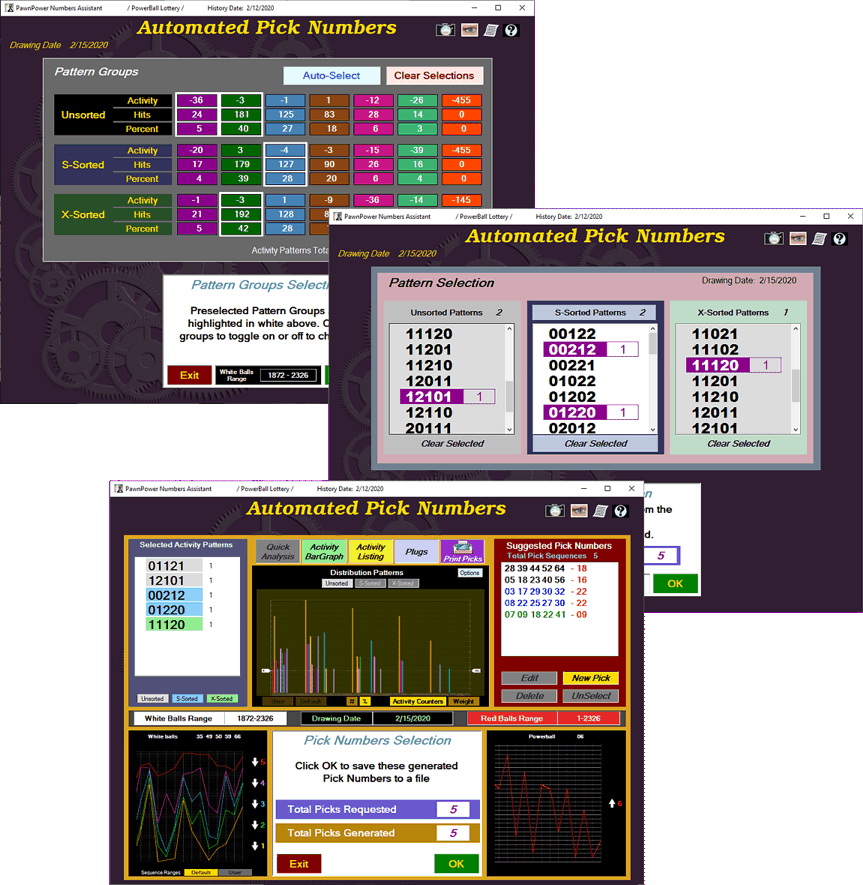
After generating your Pick Numbers, you have options to edit, delete or manually add new numbers to your list. You may print your numbers at the time they are generated or save them to an Archived file so you can load them into any of the other modules in this package for further refining. Having your Pick Numbers archived makes it very quick and easy to check for winners after the drawing. Whether you want an intelligent way to generate some smart Pick Numbers very quickly, or spend a little extra time to develop some very customized picks, this is the right tool for the job.
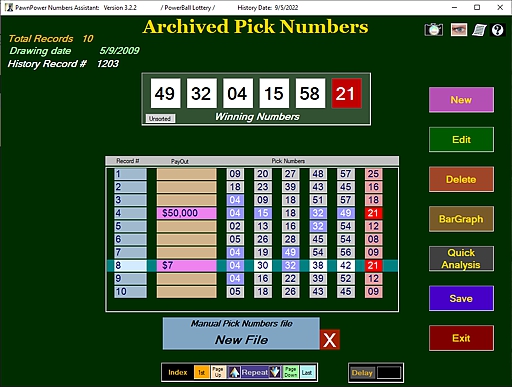
Checking your Picks for winners can't get much quicker & easier. Load your Pick Numbers file into the Archived Pick Numbers module and you'll instantly know the status of your selections. All matching Pick Number elements are highlighted so you know exactly where your matches are. Any winnings are clearly displayed within the winning entries.
We all benefit by doing things smarter. The masters in Las Vegas do it as a matter of course. They wouldn't consider depending on "Dumb Luck"... That's for suckers... And there are millions of those out there. Those blind faith players in Vegas are financing the lavish casinos and hotels, not to mention the hoards of employees that it takes to collect all of their money.
- Be patient! One big win is all it takes. Don't give up after the first few tries.
- Don't bet anything that you can't afford to lose.
- Join together with friends or co-workers and share the cost of the software and combine the benefits that you get from playing smarter with the boost in odds that comes with larger sets of Pick Numbers.
- Share the wealth when you win! Do something good for humanity or the animal kingdom as well as yourself.
- Good Luck!